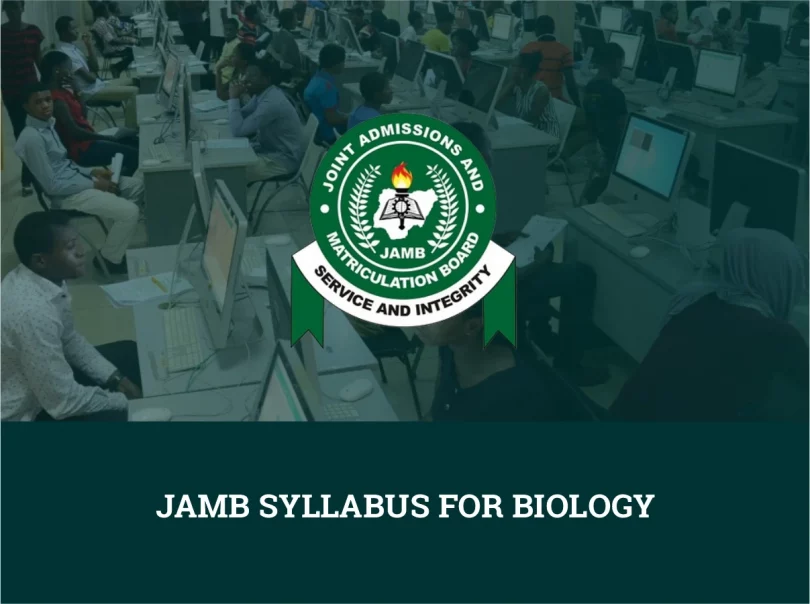Do you know that JAMB has released the syllabus for Biology for 2025? Aspirants who will be writing Biology in the examination need to have a copy of the syllabus, which is a veritable tool for candidates passing the exam with flying colours. The JAMB Syllabus for Biology provides a deeper outline of the Biology topics, subtopics, aims, objectives, examination structure, recommended textbooks, and helpful resources.
A JAMB syllabus for any subject is a structured document that outlines the key elements of a course or subject, typically used in schools. We believe that you now understand the importance of the JAMB syllabus for Biology as a JAMB candidate and in general, all other JAMB subjects.
As a candidate, if you wish to gain access to the comprehensive JAMB Syllabus for Biology to help you prepare effectively for the upcoming JAMB Biology exam, continue reading this page with great concentration and attention; all that you need to help you excel in the examination has been provided below.
A Complete Outline of JAMB Syllabus for Biology 2025
The JAMB Biology Syllabus for 2025/2026 is a comprehensive guide designed to help candidates prepare effectively for the Unified Tertiary Matriculation Examination (UTME). It outlines the topics, objectives, and recommended materials necessary for the examination.
Section A: Living Cells and Organization
| Topic | Objectives |
|---|---|
| The Cell | Understand cell structure, types, and functions. |
| Cell Structure and Functions | Identify components of plant and animal cells and their roles. |
| Cell Properties | Explain properties such as permeability, osmosis, diffusion, and surface area to volume ratio. |
| Tissues and Supporting Systems | Describe the types of tissues and their functions in plants and animals. |
| Organs and Systems | Understand the organization of cells into tissues, organs, and systems. |
| Nutrition in Plants and Animals | Explain modes of nutrition, including autotrophic and heterotrophic nutrition. |
| Transport Systems | Describe transport mechanisms in plants (xylem and phloem) and animals (circulatory system). |
| Respiratory Systems | Understand gaseous exchange and respiratory processes in plants and animals. |
| Excretory Systems | Identify excretory organs and their functions in various organisms. |
| Support and Movement | Explain support structures in plants and the skeletal system in animals. |
| Nervous Coordination | Describe the structure and function of the nervous system. |
| Hormonal Coordination | Understand the role of hormones in regulating body functions. |
| Reproduction | Explain asexual and sexual reproduction, including reproductive organs and processes. |
| Growth | Describe growth patterns and factors affecting growth in organisms. |
Section B: Continuity of Life
| Topic | Objectives |
|---|---|
| Heredity and Variations | Understand basic genetic concepts, including genes, chromosomes, and DNA. |
| Chromosomes | Describe the structure and function of chromosomes in inheritance. |
| Cell Division | Explain mitosis and meiosis and their significance in growth and reproduction. |
| Variation in Population | Identify types and causes of variation within populations. |
| Evolution | Understand the principles of evolution and natural selection. |
Section C: Concept of Living Things
| Topic | Objectives |
|---|---|
| Classification of Living Things | Classify organisms based on similarities and differences. |
| Kingdoms of Living Things | Describe characteristics of Monera, Protista, Fungi, Plantae, and Animalia. |
| Structural/Functional Adaptations | Explain how organisms adapt structurally and functionally to their environments. |
| Behavioral Adaptations | Understand behavioral strategies organisms use for survival. |
Section D: Ecology and Environment
| Topic | Objectives |
|---|---|
| Components of an Ecosystem | Identify biotic and abiotic components and their interactions. |
| Energy Flow in Ecosystems | Understand food chains, food webs, and energy pyramids. |
| Nutrient Cycling | Describe cycles such as the carbon and nitrogen cycles. |
| Population Studies | Analyze factors affecting population size and growth. |
| Pollution and Conservation | Understand types of pollution, their effects, and conservation methods. |
| Human Impact on the Environment | Evaluate the effects of human activities on ecosystems. |
| Conservation of Natural Resources | Discuss strategies for the sustainable use and conservation of resources. |
JAMB Recommended Textbooks for Biology
To effectively prepare for the JAMB Biology examination, consider studying the following recommended textbooks:
- Modern Biology for Senior Secondary Schools by S.T. Ramalingam
- Comprehensive Biology for Senior Secondary Schools by G.N.C. Eze
- New School Biology by H. Stone and Co.
- Essential Biology by M.C. Michael
Conclusion
The JAMB Biology Syllabus for 2025 serves as a clear roadmap for UTME candidates, detailing essential topics such as cell biology, genetics, ecology, evolution, and physiology. It outlines specific objectives for each topic, ensuring focused study and comprehensive preparation.
Mastery of this syllabus, along with recommended textbooks, significantly increases a candidate’s chances of achieving a high score in the Biology section of the JAMB exam.







Leave a Comment